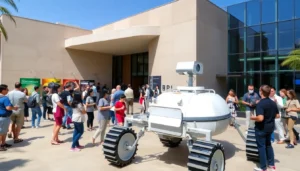Table of Contents
ToggleSpace exploration might seem like a fancy way for scientists to play with rockets, but it’s done way more for humanity than just giving us cool pictures of planets. From Tang to satellite TV, the benefits of looking up at the stars have trickled down to everyday life in ways that are as surprising as finding a sock in the dryer.
When astronauts aren’t busy floating around in zero gravity, they’re actually paving the way for innovations that improve our lives on Earth. Whether it’s advancements in technology or new medical breakthroughs, space exploration has a knack for turning cosmic curiosity into practical solutions. So buckle up as we blast off into the fascinating ways the universe has gifted us with more than just a reason to gaze at the night sky.
Advancements in Technology
Space exploration drives significant technological advancements that impact daily life. Innovations developed through these missions create practical applications across various sectors.
Development of Satellite Technology
Satellites enhance communication, weather forecasting, and navigation. Numerous satellites operate in orbit, providing critical data that supports global positioning systems (GPS). These systems assist in navigation for over 1 billion users worldwide. Additionally, satellites monitor climate changes, enabling accurate weather predictions that help millions prepare for severe weather events.
Innovations in Communication and Navigation
Communication technologies evolved due to space exploration. Advanced satellite systems facilitate instant communication across vast distances. High-speed internet access now reaches remote locations, connecting people worldwide. Navigation systems benefit from advancements in satellite technology, allowing precise tracking for military, commercial, and civilian applications. These innovations have transformed air travel, shipping logistics, and personal navigation, simplifying travel and enhancing safety.
Understanding Earth and Our Environment


Space exploration significantly enhances understanding of Earth and its dynamic systems. Through various missions, scientists gather essential data about our planet and its environment.
Monitoring Climate Change
Satellites observe Earth’s temperature, greenhouse gas emissions, and land use changes. This information allows researchers to analyze climate patterns and track shifts in ecosystems. For instance, the European Space Agency’s Sentinel satellites monitor deforestation and ice melt, providing vital insights into climate change. The data collected supports global efforts to address environmental issues, helping governments develop effective policies.
Natural Disaster Prediction and Management
Space technology plays a critical role in predicting natural disasters. Remote sensing satellites collect data on weather patterns, ocean temperatures, and seismic activity. Agencies like NASA and NOAA use this data to improve early warning systems. For example, forecasting hurricanes and tornadoes has become more accurate, saving lives. Post-disaster, satellite imagery aids in assessing damage and coordinating relief efforts. These advancements greatly enhance disaster response efficiency and community resilience.
Contributions to Medicine and Health
Space exploration has significantly advanced medical and health technologies, providing tools that improve diagnostic and treatment capabilities on Earth.
Medical Imaging Technologies
Medical imaging technologies benefited immensely from space research. NASA’s developments in digital imaging led to the creation of techniques such as magnetic resonance imaging (MRI) and computed tomography (CT) scans. These advancements allow for clearer images of internal organs, enabling accurate diagnostics and effective treatment plans. Innovations in detector technology also stemmed from space missions, enhancing image quality and resolution. Moreover, medical professionals rely on these imaging techniques to detect diseases like cancer early, improving patient outcomes.
Innovations in Pharmaceuticals
Pharmaceuticals have also seen revolutionary changes due to space exploration. Space missions enabled researchers to discover effective drugs and treatments by studying complex biological systems in microgravity. For example, the development of new protein crystals has accelerated drug design, leading to more efficient production of medications. Formulations created under space conditions often demonstrate effectiveness in treating conditions like osteoporosis and muscle atrophy. Consequently, insights gained during space research help enhance the development of life-saving drugs, directly benefiting millions of patients worldwide.
Inspiring Future Generations
Space exploration inspires future generations by fostering interest in science, technology, engineering, and mathematics (STEM). Programs that connect young students with astronauts and scientists create excitement about careers in these fields. Schools and organizations often host space-themed events, capturing children’s imaginations. These initiatives lead to an increase in STEM-related pursuits, evidenced by a rise in student enrollment in related courses.
Public interest in science and exploration receives a substantial boost from space missions. High-profile launches, like those conducted by NASA and SpaceX, generate widespread media coverage. This visibility encourages curiosity about the universe and its mysteries. Engaging documentaries and educational programs offer insights into past missions and upcoming projects. As a result, communities rally around science initiatives, celebrating achievements and expanding public understanding of space.
Economic Benefits
Space exploration generates considerable economic benefits by stimulating growth in various sectors. Investments in space lead to job creation and technological advancements that have far-reaching impacts.
Job Creation in Aerospace Industries
Aerospace industries thrive due to increased demand for skilled professionals. Thousands of jobs in engineering, manufacturing, and research emerge as private companies like SpaceX and Boeing expand operations. Additionally, government space agencies contribute to employment opportunities. For example, NASA alone supports over 300,000 jobs across the country. New roles often require specialized education and training, fostering a skilled workforce. Engineers, technicians, and scientists find diverse avenues for career development. Communities benefit as local economies grow around these aerospace hubs.
Technological Spillover into Other Sectors
Technological advancements from space exploration affect multiple industries. Innovations originally developed for space, such as satellite technology, transfer seamlessly into telecommunications. Businesses in agriculture gain from remote sensing tools that optimize crop yields and monitor environmental health. Medical fields experience breakthroughs too; research in microgravity enhances drug development and imaging technologies. Furthermore, advances in materials science inspired by aerospace missions yield stronger, lighter materials for consumer products. These transfers contribute to economic growth, demonstrating how investments in space yield returns across various sectors.







